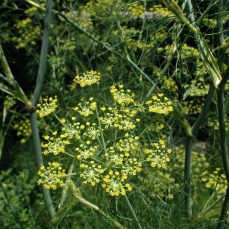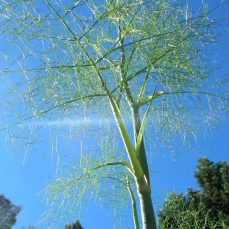Sweet Fennel (Foeniculum vulgare)

Photo credit: John M. Randall, The Nature Conservancy, Bugwood.org

Management Strategy
Squamish
Whistler
Pemberton
Vectors of Spread
Synonyms
Fennel
ID Characteristics
General: Sweet fennel is a short-lived perennial in the Apiaceae (carrot) family.
Flowers: Sweet fennel does not flower until it is 18 months to 2 years old. The small, bright yellow flowers are produced in an umbrella-shaped cluster (umbel). Each umbel section has 20-50 flowers.
Stem: Each plant is comprised of 10 – 20 upright, jointed and hollow stems that originate from a basal cluster. Stems grow 1 – 3.5 m tall and smell strongly of licorice and anise.
Leaves: Smooth, dark green leaves are finely dissected with very narrow lobes, giving a feathery, lacy appearance to the foliage. Leaves also smell like licorice and anise.
Seeds: Sweet fennel seeds are elongated (3.5 – 4mm long), dark green to brown (turning grey when dried) and ridged length-wise.
Roots: Large, deep, white taproot.
Similar Species
Invasive:
Sweet fennel is a member of the carrot family (Apiaceae), along with other invasives, such as bur chervil, giant hogweed, poison hemlock, wild carrot, wild chervil and wild parsnip.

Poison Hemlock (Photo credit: Don Hare)
Poison hemlock (Conium maculatum): Sweet fennel has a definite licorice scent and no purple spots on the stalks. Conversely, poison hemlock does not smell of licorice but does have purple blotches. Poison hemlock flowers are white, whereas sweet fennel’s are yellow.
Habitat and Origin
Sweet fennel is native to southern Europe and the Mediterranean region, where it has been used for centuries as a spice. The cause or date of its introduction to North America is unknown.
Sweet fennel prefers full sun, well-drained soil, and mild climates. It often inhabits disturbed areas, so it can be found along roadsides, pastures, prairies, streams, coastal bluffs, and wetlands.
How it Spreads
Sweet fennel reproduces vegetatively and by seed. It can form new shoots from the crown or root fragments, and seeds may lay dormant in the soil for several years before germinating.
Seeds are dispersed by water, animals, vehicles and humans. They may also contaminate agricultural produce. Sweet fennel also spreads vegetatively through its root crown.
Impacts
Ecological:
- Spreads aggressively, displacing native vegetation and dramatically altering the composition of many plant communities.
- Develops dense stands that have the potential to alter fire regimes, as dried plants facilitate the spread of fire.
- The findings of some studies suggest it has allelopathic effects.
Health:
- Can cause dermatitis if skin is exposed to sunlight following contact with the plant.
Stop the Spread
Sweet fennel is not yet found in the Sea to Sky region, but is found in neighbouring areas and may arrive here soon. The goal is to prevent sweet fennel’s introduction by focusing on education and awareness. If prevention fails, the goal will become immediate eradication following the proposed SSISC EDRR protocol.
Learn to identify sweet fennel: use the images presented on this profile page to learn how to identify sweet fennel.
What to do if you spot it: You can report any sweet fennel sighting by visiting our reporting page.
DO:
- Regularly monitor properties for weed infestations.
- Ensure soil and gravel are uncontaminated before transport.
- Ensure plants are disposed of in a garbage bag if found in floral arrangements to prevent seeds from spreading.
DO NOT:
- Unload, park or store equipment or vehicles in infested areas; remove plant material from any equipment, vehicles or clothing used in such areas and wash equipment and vehicles at designated cleaning sites before leaving infested areas.
- Plant sweet fennel in a garden, no matter how well-contained its enclosure may seem.
- Move soil that has been contaminated with sweet fennel.
- Compost sweet fennel!
Control
Mechanical
Seedlings and small plants can be dug out, but crowns and taproots must be removed to prevent regrowth. For larger infestations, plants can be repeatedly cut before flowering. This treatment may take several years to be successful. Be advised that sweet fennel can cause dermatitis (irritation) if skin is exposed to sunlight following contact with the plant. If handling sweet fennel, wear gloves and long sleeves.
Chemical
Glyphosate, triclopyr, 2,4-D are effective against sweet fennel. A combination of glyphosate and triclopyr can also be effective.
We recommend that any herbicide application is carried out by a person holding a valid BC Pesticide Applicator Certificate. Before selecting and applying herbicides, you must review and follow herbicide labels and application rates; municipal, regional, provincial and federal laws and regulations; species-specific treatment recommendations, and site-specific goals and objectives.
Biological
There are currently no available biocontrols in British Columbia.
Distribution of Sweet Fennel in BC
Sweet Fennel Factsheet
Having trouble viewing the factsheet? Don’t worry, all the information is included on this page. You can also contact us with any questions.
References
- California Nature Plant Society, Fennel
- Centre for Agriculture and Bioscience International, Foeniculum vulgare (fennel)
- Invasive Plant Atlas of the United States, Fennel
- Invasive Plants of California Wildlands, Foeniculum vulgare
- Washington State Noxious Weed Control Board, Common Fennel
- Whatcom County Noxious Weed Control Board, Common Fennel








